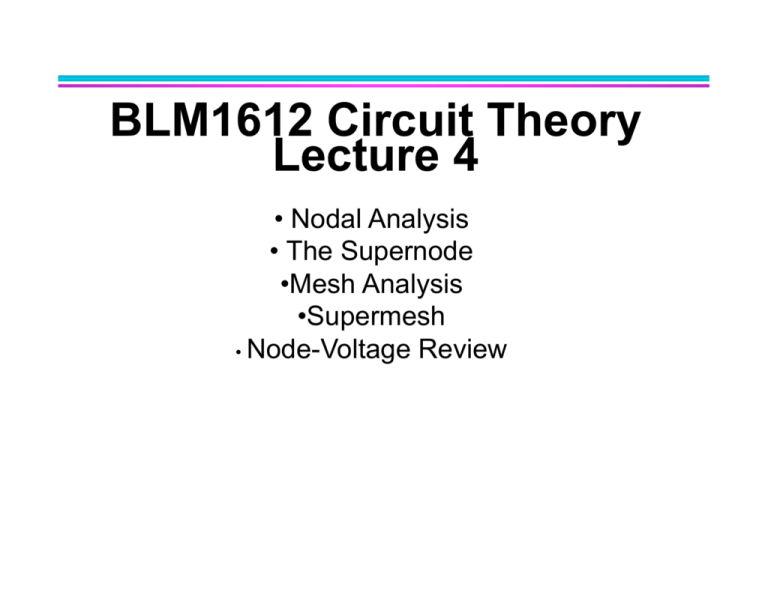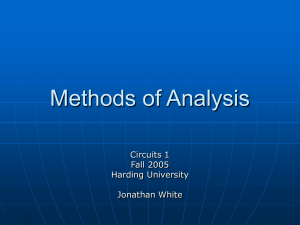CT_L4_Nodal Analysis.pptx
advertisement

BLM1612 Circuit Theory Lecture 4 • Nodal Analysis • The Supernode • Mesh Analysis • Supermesh • Node-Voltage Review Nodal (or “Node-Voltage”) Analysis • • • • a general, powerful method for methodical linear circuit analysis based on Kirchhoff’s Current Law allows us to analyze circuits for any number of nodes, N requires us to solve a system of (at least) N – 1 simultaneous equations Example (pg 82, #4.1) Determine the current flowing left to right through the 15 resistor Example (pg 83, #4.2) Determine the nodal voltages for the circuit Nodal Analysis Without Supernodes Nodal Analysis With Supernodes Example (page 91, #4.6) Determine the node-to-reference voltages in the circuit provided. • identify the nodes & supernodes • write KCL at each node (except the reference) Mesh (Current) Analysis •another powerful method for methodical linear circuit analysis •based on Kirchhoff’s Voltage Law •allows us to analyze circuits for any number of mesh currents, M •mesh = a loop that does not contain any other loops mesh current = flows only around the perimeter of a mesh 3 meshes, 3 mesh currents Mesh (Current) Analysis •another powerful method for methodical linear circuit analysis •based on Kirchhoff’s Voltage Law •allows us to analyze circuits for any number of mesh currents, M •mesh = a loop that does not contain any other loops mesh current = flows only around the perimeter of a mesh Writing Mesh Equations Writing Mesh Equations Example (page 94, #4.7) Determine the power supplied by the 2 V source Example (page 95, #4.8) Use mesh analysis to determine the three mesh currents in the circuit Example (page 96, #4.9) Mesh Analysis Without Supermesh Mesh Analysis With Supermesh Example (page 98, 4.11) Determine the three mesh currents Nodal vs. Mesh Analysis: A Comparison A planar circuit with five nodes and four meshes. Determine the current ix . Chapter 4 Summary & Review •Nodal analysis with Supernode •Choose a reference node (zero voltage); label the others v1…vn. •If the circuit contains only current sources, write KCL at each nonreference node in terms of node voltages divided by resistances & source currents. •If the circuit contains voltage sources, form a supernode around them, then apply KCL at each nonreference node & supernode. •Mesh analysis with Supermesh •Assign a mesh current to each mesh: i1…in. •If the circuit contains only voltage sources, write KVL around each mesh in terms of mesh currents mulHpled by resistances & source voltages. •If the circuit contains current sources, form a supermesh around sources common to two meshes, then apply KVL around each mesh & supermesh. •Add the equaHons that govern dependent sources, then solve N simultaneous equaHons for N unknowns.








